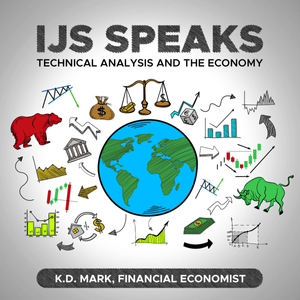
What Happens If... | IJS Speaks
05/23/23 • 7 min
We get to the Treasury’s X-date and no compromise has been made on raising the US debt limit, or in other words the anarchists get their way. The most direct impact would be felt in the bond market as investors would be in a bit of a panic, rushing to move money out of fixed income. In this type of environment, cash and liquidity will be at a premium and risk will be sold across the board to cover losses on bonds and other credit instruments. Falling bond prices will push up market interest rates, which will in turn put downward pressure on stocks. An unlikely scenario worth considering is the historically inverse relationship between stocks and bonds that underpin the 60/40 portfolio model holding through the market disruption, whereby a sharp sell-off in the fixed income space results in a rally in stocks as a function of portfolios being pre-priced and re-balanced. More likely, the run-up in both stock and bond yields from falling prices could also mean precious metals become less attractive as they do not have a carry yield, and investors do not get paid to wait. There’s also a reduction in demand from an inflation hedging standpoint as rising rates signal less credit creation, which means less upward pressure on inflation from consumption and investment spending.
The implications for commodity markets would be similar to those of other risky asset classes. If US demand for fuel is seen as waning, the price of oil will have justification to accelerate its slide lower, which probably incites more production cuts from OPEC+. The asset class whose forecast is the most opaque is crypto, as the market reaction in the space will largely depend on how volatile the moves are among the other risky assets. For example, if the broader market sell-off is orderly the crypto space could indeed act as a safe-haven for alternative liquidity. If, however, the market sell-off is violent and abrupt, the crypto space will experience the proverbial baby being thrown out with the bath water, as investors flock to liquidity in the form of fiat currency. Most likely candidates will be the Swiss Franc, Japanese Yen, and the US Dollar which all typically hold the haven status in times of great market uncertainty.
The run-up to the ‘X-date’ will be filled with market volatility with a bias to the downside. With the level of uncertainty surrounding the risk of the US government not making debt payments, investors will rightfully shift holdings away from market risk and toward liquidity. As the adage goes, “America always does the right thing, after doing everything else.” If history informs expectations, then the failure to pass the TARP legislation on the first vote comes to mind. Political lines were drawn, and the interest of the American public became an afterthought. It wasn’t until financial markets responded with a massive sell-off that Congress saw the light and voted to authorize the bailouts. With this as prologue, it’s easy to see why investors are shifting to overweight cash. The expectation is that an adverse market reaction to Congress making wrong decision at first, would present opportunities to acquire premium assets at discount prices, shortly before the right decision is subsequently made and assets again reprice to reflect the new reality.
We get to the Treasury’s X-date and no compromise has been made on raising the US debt limit, or in other words the anarchists get their way. The most direct impact would be felt in the bond market as investors would be in a bit of a panic, rushing to move money out of fixed income. In this type of environment, cash and liquidity will be at a premium and risk will be sold across the board to cover losses on bonds and other credit instruments. Falling bond prices will push up market interest rates, which will in turn put downward pressure on stocks. An unlikely scenario worth considering is the historically inverse relationship between stocks and bonds that underpin the 60/40 portfolio model holding through the market disruption, whereby a sharp sell-off in the fixed income space results in a rally in stocks as a function of portfolios being pre-priced and re-balanced. More likely, the run-up in both stock and bond yields from falling prices could also mean precious metals become less attractive as they do not have a carry yield, and investors do not get paid to wait. There’s also a reduction in demand from an inflation hedging standpoint as rising rates signal less credit creation, which means less upward pressure on inflation from consumption and investment spending.
The implications for commodity markets would be similar to those of other risky asset classes. If US demand for fuel is seen as waning, the price of oil will have justification to accelerate its slide lower, which probably incites more production cuts from OPEC+. The asset class whose forecast is the most opaque is crypto, as the market reaction in the space will largely depend on how volatile the moves are among the other risky assets. For example, if the broader market sell-off is orderly the crypto space could indeed act as a safe-haven for alternative liquidity. If, however, the market sell-off is violent and abrupt, the crypto space will experience the proverbial baby being thrown out with the bath water, as investors flock to liquidity in the form of fiat currency. Most likely candidates will be the Swiss Franc, Japanese Yen, and the US Dollar which all typically hold the haven status in times of great market uncertainty.
The run-up to the ‘X-date’ will be filled with market volatility with a bias to the downside. With the level of uncertainty surrounding the risk of the US government not making debt payments, investors will rightfully shift holdings away from market risk and toward liquidity. As the adage goes, “America always does the right thing, after doing everything else.” If history informs expectations, then the failure to pass the TARP legislation on the first vote comes to mind. Political lines were drawn, and the interest of the American public became an afterthought. It wasn’t until financial markets responded with a massive sell-off that Congress saw the light and voted to authorize the bailouts. With this as prologue, it’s easy to see why investors are shifting to overweight cash. The expectation is that an adverse market reaction to Congress making wrong decision at first, would present opportunities to acquire premium assets at discount prices, shortly before the right decision is subsequently made and assets again reprice to reflect the new reality.
Previous Episode

Safety and Liquidity Still Matter | IJS Speaks
Since the lows of last October (2022), financial markets have rebounded higher in-line with the post COIVD re-opening of the Chinese economy and a simultaneous mild winter in Europe. At home, we have also experienced an exceptionally resilient labor market in the face of tightening monetary policy and subsequently credit conditions. Measures of inflation in the US economy are trending lower from their post-COVID peaks of around 10%, which is great news, but being above 4% is still nowhere near the Fed's target of 2% so its safe to expect more policy tightening from the central bank. The market reaction to more of the same from the Fed might be a little different going forward as expectations fall in-line with the economic reality the world faces. As inflation has been falling in the US over the past couple of fiscal quarters, so has the dollar as market participants anticipated an eventual pivot in monetary policy back towards accommodation and easy money.
The coming couple of fiscal quarters will probably see the impacts of rising interest rates finally hit the labor market in a meaningful way. Thus far the recent memories of labor shortages during the post-COVID re-opening in the US, means employers are more likely to cut hours versus cutting headcount. The apparent labor hoarding has been supporting wages, which paired with falling inflation means consumers have been experiencing real increases in their income, albeit from depressed levels. Stocks markets have latched-on to this idea and are reflecting a world where economic activity slows just enough to bring inflation down, but not enough that lots of people lose their job as a result of the slowdown. Classic case of wishful thinking.
The labor market tends to be a lagging indicator of economic activity, and so by the time businesses en-masse decide that its not worth holding onto a full staff and labor supply overshoots labor demand, interest rates would have been too high for too long and the damage would have already been done. As the summer months approach, market participants will have to adjust their expectations for economic activity in the back half of the year. Consider two scenarios: 1) The rate of change of the drop in inflation slows and the Fed keeps ratcheting up interest rates until economic activity grinds to a halt, and we get an acceleration in unemployment and inflation finally drops back down to the Fed target with a recession. 2) The long and variable lag in monetary policy is realized and market participants conclude the Fed has already gone too far as the rate of change of the drop in inflation accelerates taking it below the Fed target and creating an event sharper jump in unemployment, resulting in a recession. We are dealing with an issue of what flavor of recession will (not can) the Fed create. The difference being short and deep where there is a sudden drop in inflation and economic activity which the Fed can quickly address with interest rate cuts. Versus long and shallow where there is a grind lower in economic activity and inflation, to which the Fed's response will be hesitation to accommodate as they will fear a resurgence of inflation which would put them in the opposite of liquidity trap, where addressing one problem exacerbates another. In either scenario, the US consumer goes on the defensive and corporate earnings are directly affected negatively.
Next Episode

Chart Patterns Paint a Clearer Picture | IJS Speaks
There is this Cup-and-Handle formation that is evolving on a 3-month chart of the Dollar Index, and I think the chart is presenting at the beginning of the handle portion of the chart pattern. I’ve been watching and trend-trading the dollar index against a basket of currencies, because I believe the forex markets have the most immediate link to the macroeconomy, and we are certainly living in interesting macroeconomic times. Cup-and-Handle chart patterns tend to signal a continuation of a trend in the direction of the breakout, so I zoomed out to a 1-year chart and saw what I initially thought was a ‘kinda weird’ Double Bottom formation, had the potential to form a ‘not-so weird’ (inverted) Head-and-Shoulders if the Cup-and-Handle played out. Technical Analysis talk aside, all three of the aforementioned chart patterns told me the same thing; the dollar was queuing up for a move higher.
The Cup-and-Handle overlays best with the current narrative in financial markets. The dollar first started trending higher as the debt ceiling negotiations began intensifying and the date estimated by the Treasury when America would run out of cash to pay its bills approached without an agreement. Before that point the dollar was trending sideways for about a month, which came after about a month of trending lower. The short-term peak in the dollar occurred around the time an agreement was reached between Democrats and Republicans about the US debt. This is when the pattern caught my attention, as the price on the index started rolling over into the beginning of the handle.
The next macro event on the economic calendar is the June Fed meeting (13th-14th) which will conclude with the Fed deciding to either raise interest rates or hold them at current levels until their next meeting in July. The market consensus appears to be that the Fed will hold rates steady at its next meeting and maybe even at its subsequent one, which is in-line with what Fed officials have been saying. Then the two go their separate ways. The Fed has and continues to say that rates are meant to stay higher for longer, and market participants are suggesting that rate cuts can begin as early as the fourth quarter of this year. Financial markets are also implying that because the Fed should be cutting rates by years end, the dollar has peaked and should be weakening as higher foreign rates begin to look more attractive.
The inevitable divergence of views between the Fed and market participants completes the handle in the formation. The capitulation of market participants will later drive the breakout of the pattern, which on the longer timeframe would lineup with the breakout of the (inverted) Head-and-Shoulders as well.
Let me explain. Markets agree with the Fed that rates remain unchanged at the June meeting, which to the Fed means rates remain unchanged at the June meeting and nothing more. To market participants, however, it means rates have peaked and after a short pause they are coming down, so the dollar sells off. When we get to the next meeting if there is still no rate change because monetary policy operates with long and variable lags, markets will infer that we’re even closer to a rate cut especially if the economic data worsen, so the dollar may tend to trade sideways. Finally capitulation can/may occur when later in the year the Fed surprises markets with a rate increase despite further deterioration in the economic environment simply because inflation will have remained sticky above their target of 2%. Short dollar positions would have to cover losses, and some will even reverse course, all of which will push the dollar higher.
Then there’s the issue of the Fed further tightening monetary policy while economic activity slows, while labor hoarding and consumer credit keeps a floor under inflation. Economic weakness at home and abroad could move the needle on market sentiment towards one that embraces...
If you like this episode you’ll love
Episode Comments
Generate a badge
Get a badge for your website that links back to this episode
<a href="https://goodpods.com/podcasts/technical-analysis-and-the-economy-271843/what-happens-if-ijs-speaks-32761048"> <img src="https://storage.googleapis.com/goodpods-images-bucket/badges/generic-badge-1.svg" alt="listen to what happens if... | ijs speaks on goodpods" style="width: 225px" /> </a>
Copy




